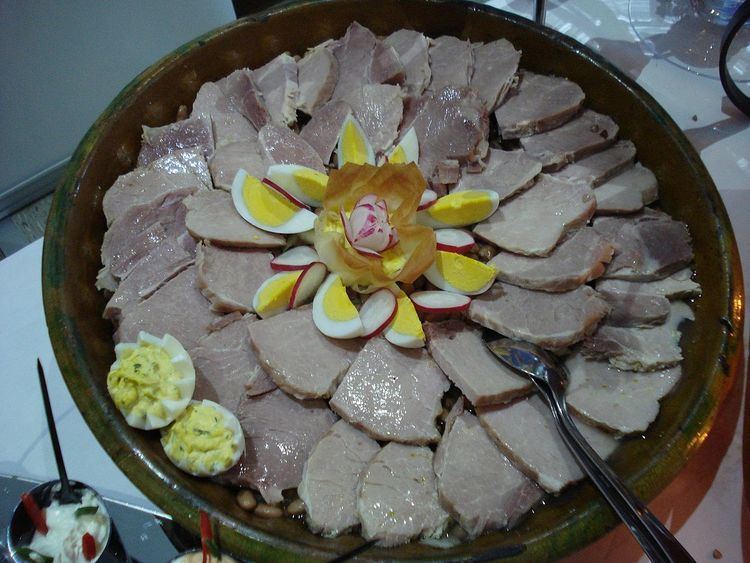 | ||
Croatian cuisine is heterogeneous and is known as a cuisine of the regions, since every region of Croatia has its own distinct culinary tradition. Its roots date back to ancient times. The differences in the selection of foodstuffs and forms of cooking are most notable between those in mainland and those in coastal regions. Mainland cuisine is more characterized by the earlier Slavic and the more recent contacts with neighboring cultures—Hungarian and Turkish, using lard for cooking, and spices such as black pepper, paprika, and garlic. The coastal region bears the influences of the Greek and Roman cuisine, as well as of the later Mediterranean cuisine, in particular Italian (especially Venetian). Coastal cuisines use olive oil, and herbs and spices such as rosemary, sage, bay leaf, oregano, marjoram, cinnamon, clove, nutmeg, and lemon and orange rind. Peasant cooking traditions are based on imaginative variations of several basic ingredients (cereals, dairy products, meat, fish, vegetables) and cooking procedures (stewing, grilling, roasting, baking), while bourgeois cuisine involves more complicated procedures and use of selected herbs and spices. Charcuterie is part of Croatian tradition in all regions. Food and recipes from other former Yugoslav countries are also popular in Croatia.
Contents
- Meat and game
- Seafood
- Pasta
- Soups
- Side dishes
- Cheese sir
- Savoury pies
- Pastry
- Sweets and desserts
- Cakes kolai
- Wines
- Dessert wines
- White wines
- Red wines
- Beers pivo
- Liqueurs and spirits
- Coffee
- Mineral water
- References
Croatian cuisine can be divided into a few regional cuisines (Istria, Dalmatia, Dubrovnik, Lika, Gorski Kotar, Zagorje, Međimurje, Podravina, Slavonija) which all have their specific cooking traditions, characteristic for the area and not necessarily well known in other parts of Croatia. Most dishes, however, can be found all across the country, with local variants.
Meat and game
Croatian meat-based dishes include:
Seafood
Croatian seafood dishes include:
Pasta
Pasta is one of the most popular food items in Croatian cuisine, especially in the region of Dalmatia. The so-called manistra na pome = pasta with tomato sauce is a staple. The other popular sauces include creamy mushroom sauce, minced meat sauce and many others. Also, potato dough is popular, not only for making njoki (gnocchi), but also for making plum or cheese dumplings which are boiled, and then fried in breadcrumbs and butter.
Soups
Soup is an integral part of a meal in Croatia and no Sunday family meal or any special occasion will go without it. The most popular soups are broth based, with added pasta or semolina dumplings. They are usually light in order to leave space for the main course and dessert to follow. However, cream or roux based soups are also popular, and there are many local variations of traditional soups. In Dalmatia, one of the most loved ones is the fish soup with fish chunks, carrots and rice.
Side dishes
Cheese (sir)
Savoury pies
Viška pogača is a salted sardine filled foccacia from the island of Vis. Soparnik is a Dalmatian chard filled pie.
Pastry
Sweets and desserts
Cakes (kolači)
Wines
Croatia has two main wine regions: Continental (Kontinetalna) and Coastal (Primorska), which includes the islands. Each of the main regions is divided into sub-regions which are divided yet further into smaller vinogorje, (literally wine hills) and districts. Altogether, there are more than 300 geographically-defined wine-producing areas in Croatia. In parts of Croatia, wine, either red or white, is sometimes consumed mixed in approximately equal proportions with water.
Dessert wines
White wines
Red wines
Beers (pivo)
Apart from the great abundance of imported international beers (Heineken, Tuborg, Gösser, Stella Artois, etc.), there are some home-brewed beers in Croatia. Also, a brewery based in Split produces Bavarian Kaltenberg beer by licence of the original brewery in Germany.
Liqueurs and spirits
Coffee
Croatia is a country of coffee drinkers (on average 5kg per person annually), not only because it was formerly part of the Austrian-Hungarian Empire, but also because it bordered the former Ottoman Empire. Traditional coffee houses similar to those in Vienna are located throughout Croatia.
Mineral water
Regarding its water resources, Croatia has a leading position in Europe. Concerning water quality, Croatian water is greatly appreciated all over the world. Due to a lack of established industries there have also been no major incidents of water pollution.
